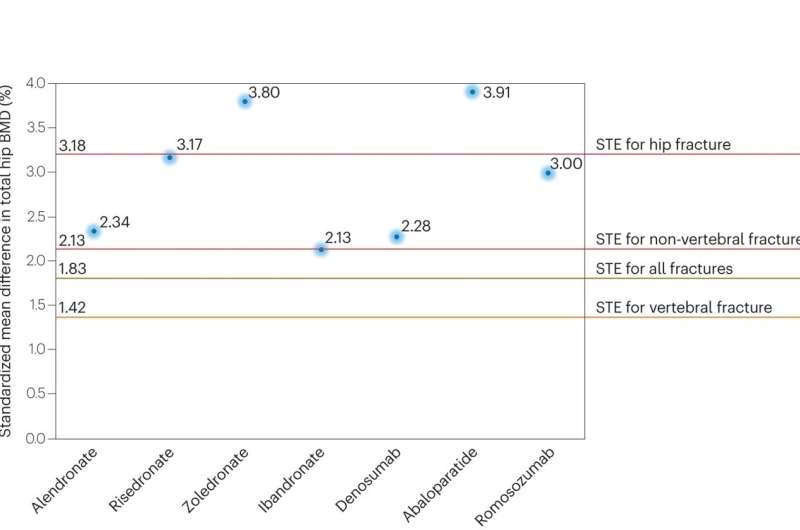This article has been reviewed according to Science X's editorial process and policies. Editors have highlighted the following attributes while ensuring the content's credibility:
fact-checked
trusted source
proofread
New evidence-based guideline for the management of osteoporosis in men

Worldwide, it is estimated that one in five men over the age of 50 years will experience an osteoporotic fracture in their remaining lifetime, and the number of hip fractures in men is expected to rise by approximately 310% between 1990 and 2050. Despite its great burden among older men, osteoporosis is still often viewed as a 'woman's' disease, and underdiagnosis and undertreatment of the condition in men are even more prevalent than in women.
In response, an international multidisciplinary working group of the European Society for Clinical and Economic Aspects of Osteoporosis, Osteoarthritis and Musculoskeletal Diseases (ESCEO) has now issued GRADE-assessed recommendations for the diagnosis, monitoring, and treatment of osteoporosis in men.
Professor Jean-Yves Reginster, senior author and President of ESCEO, stated, "It's important to recognize that osteoporosis in men carries substantial morbidity and mortality, with rates comparable to or even exceeding those in women with the condition."
"The ESCEO international working group was convened to provide new management recommendations that are informed by the latest developments in research and up-to-date expert opinion related to diagnostic and screening approaches for osteoporosis and its associated high fracture risk in men."
The Working Group recommendations cover disease burden, approaches to fracture risk assessment in men, including appropriate interpretation of bone densitometry and absolute fracture risk, thresholds for treatment, and interventions that can be used therapeutically together with their health economic evaluation.
The guidance also notes the need for more research with future work specifically addressing the efficacy of anti-osteoporosis medications, including denosumab and bone-forming therapies.
Among the key recommendations and guidelines, the following may be particularly useful for clinicians:
- A female reference database should be used for the densitometric diagnosis of osteoporosis in men.
- FRAX is the appropriate tool for the assessment of fracture risk and as the basis for setting intervention thresholds in men with osteoporosis.
- FRAX-based intervention thresholds should be age-dependent in men with osteoporosis.
- Trabecular bone score, used with BMD and FRAX probability, provides useful information for fracture risk assessment in men.
- All men with a prior fragility fracture should be considered for treatment with anti-osteoporosis medications.
- The anti-osteoporosis treatment regimen in men should be adapted to an individual's baseline fracture risk.
- Vitamin D and calcium repletion should be ensured in all men above the age of 65 years.
- Oral bisphosphonates (alendronate or risedronate) are first-line treatments for men at a high risk of fracture.
- Denosumab or zoledronate are second-line treatments for men at a high risk of fracture.
- A sequential therapy starting with a bone-forming agent followed by an anti-resorptive agent should be considered for men at a very high risk of fracture.
- Biochemical markers of bone turnover are the appropriate tool to assess adherence to anti-resorptive therapy in men.
- Bone-forming agents when given as first-line treatment in men at a very high risk of fracture, should be used in accordance with the recommendations of the regulatory authorities.
- Physical exercise and a balanced diet should be recommended to all men with osteoporosis.
- Serum total testosterone should be assessed as part of the pre-treatment assessment of men with osteoporosis.
- Appropriate hormone replacement therapy should be considered in men with low levels of total or free serum testosterone.
- Based on available BMD data, abaloparatide is considered an appropriate first-line treatment for men with osteoporosis at a very high risk of osteoporotic fracture.
Professor Nicholas Harvey, senior author and chairman of the International Osteoporosis Foundation (IOF) Committee of Scientific Advisors, noted, "We hope that these guidelines will assist clinicians in their clinical practice and encourage them to be proactive in managing osteoporosis in their male patients."
"Following an approach similar to that advocated for women with osteoporosis, we recommend the use of oral anti-resorptive agents as first-line agents in men at a high risk of fracture and the use of bone-forming agents followed sequentially by anti-resorptive agents in men at a very high risk of fracture."
IOF CEO Dr. Philippe Halbout concluded, "Osteoporosis in men poses an enormous global burden, and must be urgently addressed by health care providers as well as health authorities. As the world's largest global organization in the osteoporosis arena, IOF welcomes the publication of this important new guideline which we hope will contribute to better patient care and to reducing the devastating consequences of osteoporosis in older men around the world."
The work is published in the journal Nature Reviews Rheumatology.
More information: Nicholas R. Fuggle et al, Evidence-Based Guideline for the management of osteoporosis in men, Nature Reviews Rheumatology (2024). DOI: 10.1038/s41584-024-01094-9




















